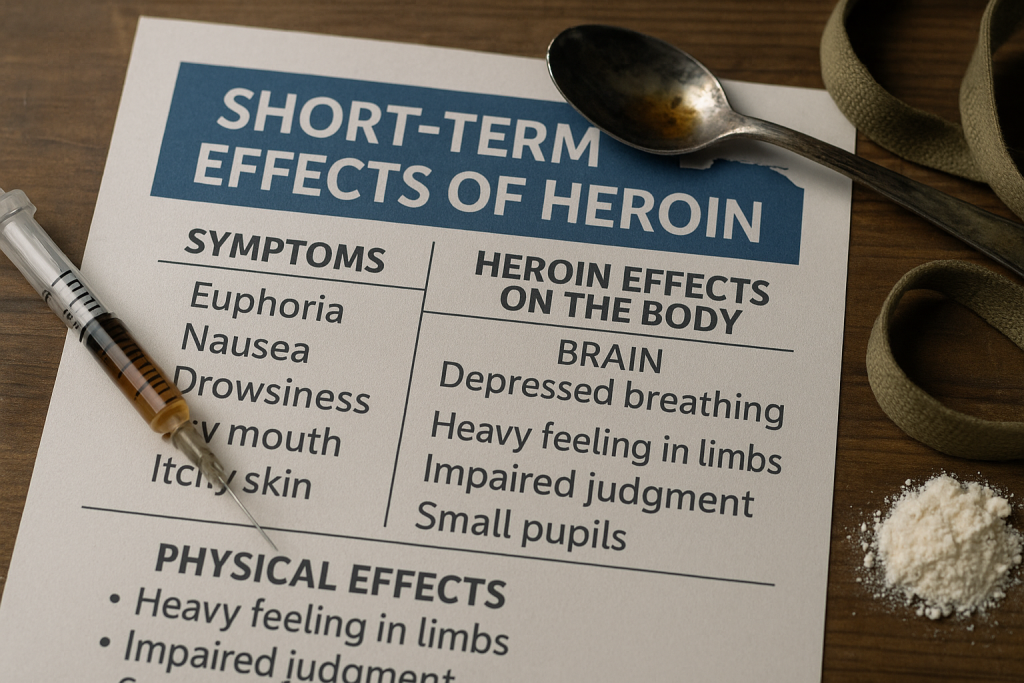Last Updated on September 30, 2025
Table of Contents
Heroin is a powerful opioid derived from morphine, a natural substance found in certain types of poppy plants. It is illegal, highly addictive, and associated with a wide range of harmful health consequences. Many people first experiment with heroin without understanding how dangerous it can be—even in the short term.










This article explains the short-term effects of heroin on the body and brain, what heroin feels like, and why it is so addictive. It will also explore the negative effects, symptoms, and signs of addiction so readers can recognize the dangers and seek help.
What Does Heroin Do to the Brain?
Heroin enters the brain quickly and binds to opioid receptors, especially those involved in feelings of pain and pleasure. These receptors also regulate heart rate, breathing, and sleeping.
Once it binds to these receptors, heroin floods the brain with dopamine, producing an intense rush of euphoria. This is often what makes heroin so addictive—the brain begins to crave that pleasurable sensation, and tolerance develops rapidly.
Over time, the brain’s reward system is rewired, making it increasingly difficult to experience pleasure from anything other than heroin. This is why many people ask, “why is heroin so addictive?”
What Does Heroin Feel Like?
Users describe heroin’s initial effects as a “rush” of intense euphoria, warmth, and relaxation. This sensation can happen within seconds of injecting the drug or within minutes when smoked or snorted.
However, this initial high quickly fades, leaving behind heavy drowsiness and clouded thinking. The “nodding” phase—where users slip in and out of consciousness—is a dangerous state that can lead to overdose.
So while people may chase that initial high, the reality is that heroin produces short-term effects that carry severe health risks.
Short-Term Effects of Heroin on the Body
Even a single use of heroin can cause noticeable changes in the body. Some of the most common short-term effects of heroin include:
Euphoria: A surge of pleasure and relaxation.
Drowsiness: Extreme sleepiness, sometimes referred to as “on the nod.”
Slowed breathing: Respiratory depression, which can be life-threatening.
Constricted pupils: A telltale sign of opioid use.
Itchy skin: Caused by histamine release in the body.
Dry mouth: A common and uncomfortable side effect.
Nausea and vomiting: Heroin irritates the stomach lining.
Slowed heart rate and blood pressure: This can put users at risk of collapse.
Even when these effects do not seem severe, they can quickly escalate to dangerous complications.
Freedom Starts Here. Take Back Your Life Today.
Same-Day Admissions in Austin Available.
Short-Term Effects of Heroin on the Brain
The heroin function in the brain is to depress the central nervous system, which slows both mental and physical processes. Some short-term brain effects include:
Clouded mental functioning: Difficulty concentrating or making decisions.
Impaired coordination: Increased risk of accidents or injuries.
Confusion and disorientation: Users may lose awareness of their surroundings.
Reduced response to pain: A temporary numbing effect that increases risk of injury.
These brain effects make heroin especially dangerous because they impair judgment and increase the risk of risky behaviors or accidental overdose.
Negative Effects of Heroin
While some people focus only on the pleasurable sensations heroin produces, the negative effects of heroin are far more significant. These can begin immediately after use and include:
Risk of overdose: Slowed breathing can quickly become fatal.
Collapsed veins: For those who inject heroin.
Infections: Sharing needles increases the risk of HIV, hepatitis, and bacterial infections.
Skin problems: Frequent scratching may cause rashes or sores.
Legal consequences: Heroin possession and use are criminal offenses in the U.S.
The reality is that the so-called “positive” effects of heroin are short-lived, while the negative effects can be devastating and long-lasting.
Heroin Symptoms: Recognizing Short-Term Use
Identifying heroin symptoms early can save lives. Common signs someone has recently used heroin include:
Tiny (pinpoint) pupils
Sudden drowsiness
Slurred speech
Slow movements or poor coordination
Flushed or warm skin
Runny nose (if snorted)
Track marks (if injected)
If you observe these heroin symptoms in someone, they may be under the influence and at risk of overdose.
Heroin Effects on the Body: Beyond the High
While the initial rush may feel pleasurable, the effects of heroin on the body are overwhelmingly harmful. Repeated use, even over a short time, damages vital organs. These effects include:
Lung complications from slowed breathing
Weakened immune system
Dehydration and electrolyte imbalances
Gastrointestinal issues
Risk of blood clots from injections
These physical consequences make heroin one of the most dangerous drugs in the world.
Why Is Heroin So Addictive?
Heroin’s addictive nature stems from how rapidly it enters the brain and how powerfully it stimulates the reward system. The rush of dopamine creates a strong psychological drive to repeat the experience.
Additionally, tolerance builds quickly, meaning users need more heroin to feel the same effects. Physical dependence follows, causing painful withdrawal symptoms if use is stopped. This cycle of craving, tolerance, and withdrawal is what makes heroin so addictive.
Heroin Addict Signs
Recognizing heroin addict signs early can help someone get treatment before the damage becomes irreversible. Warning signs include:
Neglecting responsibilities at work, school, or home
Sudden financial or legal problems
Track marks, scars, or infections from injections
Severe weight loss and malnutrition
Loss of interest in hobbies and relationships
Frequent “nodding off” or drowsiness
Hidden paraphernalia (needles, burnt spoons, foil)
If you notice these signs in a loved one, it’s important to encourage them to seek professional help.
Short-Term Risks That Lead to Long-Term Damage
Even if someone uses heroin only once, the risk of overdose or long-term brain changes is real. The combination of euphoria, sedation, and respiratory depression makes heroin unpredictable and extremely dangerous.
That’s why understanding the short-term effects of heroin is crucial—not to glamorize its use, but to highlight just how quickly it can destroy health and life.
Beyond symptoms, here’s the cost of heroin addiction in Austin for families and communities.
FAQ: Heroin Effects and Symptoms
What does heroin feel like?
Heroin creates a rush of euphoria, warmth, and relaxation, followed by extreme drowsiness.
What are the short-term effects of heroin?
They include euphoria, slowed breathing, nausea, pinpoint pupils, confusion, and drowsiness.
What does heroin do to the brain?
It binds to opioid receptors, floods the brain with dopamine, and depresses the central nervous system.
Why is heroin so addictive?
Heroin is addictive because it causes an intense dopamine rush, builds tolerance quickly, and produces painful withdrawal symptoms.
What are the negative effects of heroin?
They include risk of overdose, collapsed veins, infections, lung damage, and long-term cognitive decline.
What are heroin addict signs?
Signs include track marks, drowsiness, sudden financial issues, hidden paraphernalia, and withdrawal from responsibilities.
What are heroin symptoms of short-term use?
Pinpoint pupils, warm skin, nausea, slow movements, and slurred speech are common symptoms after heroin use.
Heroin’s short-term effects may seem appealing to those seeking relief or escape, but the reality is grim. The negative effects of heroin far outweigh any temporary high. From slowed breathing and nausea to overdose and addiction, the dangers are immediate and life-threatening.
By recognizing the heroin symptoms and heroin addict signs, families and friends can help loved ones seek treatment. Recovery is possible with medical detox, counseling, and long-term support.


